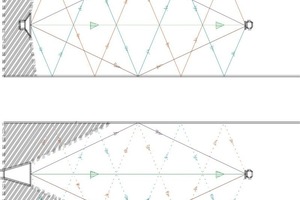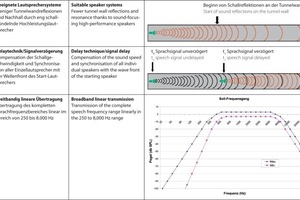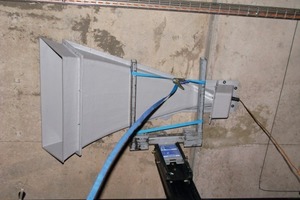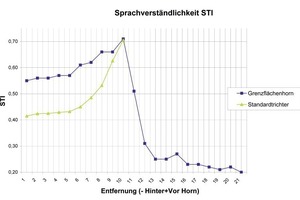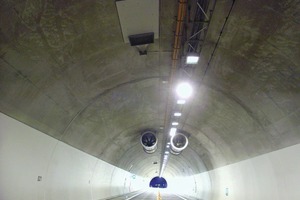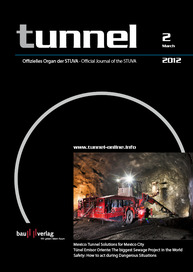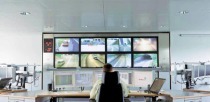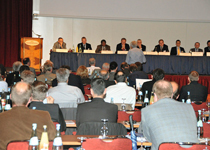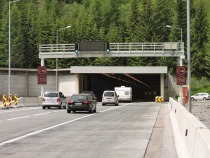Clear Announcements for Motorists: New Chances for safe Voice Alarms in Tunnels
Loudspeaker announcements, whose efficacy largely depends on their comprehensibility, provide assistance for tunnel users on how to act properly during dangerous situations. The following report provides indications of how to more effectively improve comprehensibility.
Loudspeaker announcements are numbered among the safety facilities, which are essential for the evacuation of tunnel users in the event of a fire or other incident. Acoustic information is not distorted in the smoky environment and people react faster and more precisely to verbal communication than to general warnings of danger or optical symbols. The advantages of rapid and targeted information for the tunnel user via speaker announcements was recognised in the “Guidelines for Furnishing and Operating Road Tunnels” (RABT) first published in 1985 and have been adhered to since.
However it is imperative that the information passed on can be well understood to ensure the efficacy of communication. The acoustics within a road tunnel with immense resonance and the noise caused by traffic set high obstacles for comprehensibility. The all-call system, which is the most important form of communication for tunnels in operation, in other words a constant call over the entire length of one bore, fell into the “incomprehensible” category as far as the majority of tunnels were concerned. As however RABT [1] does not simply advocate the installation of the system but also the comprehensibility of loudspeaker announcements, it is essential that the existing contradiction between what is justifiably demanded and actual acoustical practice is rectified through more extensive investigations. The Federal Highway Research Institute on behalf of the Federal Ministry of Transport, Building and Urban Development (BMVBS) commissioned the Ingenieurbüro IFB Consulting to tackle these investigations.
The investigations are aimed at arriving at more extensive demands on electro-acoustic systems in road tunnels taking technical and economic applicability into consideration. Initially it has to be clarified whether obvious potentials for improving existing acoustic results are available. Consequently it has to be determined whether acoustic systems on the basis of defined types of tunnel possessing different acoustic properties can be designed without complicated tests being executed for each individual case or by reducing the scope of the planning process. The results are intended to provide concrete recommendations to be integrated in the technical code of practice for road tunnels.
Starting Point for Investigations
Acoustic-theoretical principles, novel acoustic-technical concepts as well as further results from research projects and investigations on tunnel acoustics had to be analysed and compared to the findings from a number of sound-technical individual investigations on road tunnels, which were established by the researcher quite independent of the research project. It was intended to determine acoustic parameters relevant for sound systems given different tunnel geometries with the appropriate technical measurements. These were to be accompanied by the definition of precise basic requirements on the electro-acoustic functional parameters of sound systems. A follow-up market analysis was intended to show the available market potential for electro-acoustic equipment not used on the tunnel sector relating to improving comprehensibility of voice information in tunnels.
After determining suitable requirements the various tunnel acoustic concepts had to be examined relating to the electro-acoustic objective voice comprehensibility parameters that could be attained in each case. In this basically experimental part of the project comparative investigations were carried out in a road tunnel involving different acoustic concepts in the form of fundamental measurement set-ups. The initial preliminary results obtained from these test set-ups resulted in the investigative approach strongly focused on a concept described as a “synchronised longitudinal acoustics system”, in conjunction with the issue as to how the concept would present itself under the real conditions of a complete tunnel sound system. A tunnel being refurbished was equipped at short notice with loudspeaker systems, which were optimised to comply with the acoustic conditions prevalent in a road tunnel and thus enabling this concept to be examined even further under real tunnel conditions, derivation of objectives for the assessment of corresponding sound systems as well as formulating general rules for setting them up.
Results and Application
The researcher, which had already been involved with acoustic studies in 19 transport tunnel projects in its function as a consulting engineer, systematically evaluated acoustic and sound tunnel parameters. In conjunction with the subsequent individual investigations in a road tunnel existing results were clarified and rectified both with respect to tunnel acoustics as well as the characteristics of various tunnel sound concepts. The Speech Transmission Index (STI) was taken as the basis for the criterion to assess the determined acoustic information.
The path from the speech comprehensibility dilemma in tunnel acoustics led via 2 parameters, which had to be influenced or used:
1. The sound reflections on the tunnel walls responsible for the resonance had to be reduced.
2. The special sound propagation within the tunnel geometry can be applied as a useful parameter.
The sound reflections on the tunnel walls responsible for the resonance result from a large number of possible reflection paths. Fig. 1 presents a possibility for reduction by varying the type of loudspeaker.
A road tunnel that was close to completion was used for experimental investigations in order to obtain precise details of tunnel acoustic parameters by scientific means, especially the sound conducting properties of these special tunnel systems. Three sound systems were compared as experimental model set-ups:
• The conventionally distributed loudspeaker set-up using horn loudspeakers assembled at short intervals in the wall or ceiling. Information was transmitted simultaneously via all installed loudspeakers.
• So-called sequential communication, which has been used in practice on a number of occasions since 2005. In this case transmitting is firstly undertaken using only a few loudspeakers in a restricted section of the tunnel (whose sound fields are furthermore synchronised with one another). All loudspeakers that are situated some distance away remain “silent” (for the time being). Once the transmission in the first section is completed, transmission in the next section follows with a time delay.
• The still untested concept of synchronised longitudinal transmission (subsequently known as the “SLASS concept” – SLASS = synchronised longitudinal announcement speaker system). This concept entails transmission directed in the tunnel’s longitudinal direction in conjunction with an electronic delay, which synchronises the subsequent speakers with the sound field of the first speakers dependent on the sound speed. Fig. 2 displays the principle.
The results of the individual investigations contained in the report revealed that sufficient comprehensibility cannot be attained with a conventional loudspeaker arrangement and its activation. This was once again confirmed in the tunnel.
Sequential transmission merely used the resonance parameter to improve comprehensibility: by means of only segment-by-segment transmission and sequences following each other chronologically resonance from the other tunnel segments was eliminated so that speech comprehensibility within the affected segments was significantly increased. Transmission took place via conventional speakers. The research results on this concept confirmed the fact known from practice that sufficient speech comprehensibility can be attained in this manner. As however the sequential concept does not permit transmission to all tunnel segments at the same time (genuine all-call) all calls have to be repeated several times – something which unfavourably multiplies the transmission of information to all parts of the tunnel depending on its length.
On the other hand the (SLASS) concept, which so far has only been described theoretically, is intended to use both parameters resonance and sound propagation in conjunction with a type of speaker optimised for this purpose. Thanks to very large, sound-focusing speakers, Fig. 3 displays a model already available, which emits sound along the tunnel without however emitting any perceptible quantities of sound energy against the nearby tunnel walls, little sound is reflected from these wall areas and consequently the resonance is reduced. At the same time sound waves are reflected on the tunnel walls at acute angles at a considerable distance from the loudspeaker. This effect tat can only be exploited in tunnels is intended to increase the effective direct sound proportion over a long distance so that a great deal of sound relevant for comprehensibility can be transmitted over a major distance with relatively few speakers.
The practical applicability of these theoretical deliberations was proved successfully within the scope of the prior investigations. The pronounced influence of the model on the attainable speech comprehensibility index was also shown (Fig. 4).
In order to communicate properly within an entire tunnel the individual sound fields must be synchronised in keeping with the set-up presented in Fig. 2, in order to avoid destructive echo effects and the emission of additional resonance energy, depending on the sound propagation speed i.e. each speaker has to be activated by a separate electronically delayed signal. In addition to loudspeaker emission parameters further specifications relating to the tolerance of running time synchronisation, the sound pressure to be attained by the receiver and the transmitted frequency range were determined thus attaining the high comprehensibility required in practice.
During the duration of the research project for the first time a complete SLASS system was installed in a roughly 800 m long tunnel that was being refurbished. The outcome was that a speech transmission index of more than < 0.50 was confirmed as had been predicted although it was not actually believed attainable in a tunnel for an all-call system. The high speech transmission index that was arrived at turned out to be highly comprehensible when tried out with speech announcements in tests under field conditions influenced by noise produced by jet fans and vehicles.
Summary and Outlook
The guarantee and (constant) improvement of safety in road tunnels is an important and generally recognised target in Germany. Comprehensible loudspeaker announcements contribute towards proper behaviour on the part of motorists both in the event of fire as well as during other incidents. Whereas in the event of fire self-rescue of affected persons in particular is improved by means of appropriate measures, quick information is intended to contribute to tunnel operation flowing smoothly in the case of other incidents (accident, breakdown).
The results of the research project represent considerable progress in speech comprehension for speaker announcements in tunnels using the synchronised longitudinal sound concept. On this basis the concept has emerged as being superior to previous sound alternatives and will be the type of installation chosen for use in tunnels in future. Since the results were announced more than 10 tunnels in Germany have been equipped with this new technology so that the outcome of this research has been reflected in practice from the very outset.
In order to exploit electro-acoustic installations in tunnels to an even greater extent some still unanswered questions have to be clarified as for instance efficient adaptation of sound volumes to changing noise levels, the systematic inclusion of the escapeways and the portal zones, the delivery of speech announcement texts and standardised operation ergonomics for speech announcements.
The results of the research project are contained in an extensive and lucid report. This report is available as Report B 80 bearing the title “Loudspeaker Systems and acoustic Signalling in Road Tunnels” in the BASt series of publications [2]. At present the corresponding codes of practice on operating road tunnels are being revised to further increase tunnel safety. As a result it is assured that important research results are quickly included in the appropriate standards.

